- Home
- Stephen E. Ambrose
The Victors: Eisenhower and His Boys Page 4
The Victors: Eisenhower and His Boys Read online
Page 4
“That marked a turning point for me,” Tipper recalled. “Before Sobel’s raid I had disliked him but had not really hated the man. Afterward I decided Sobel was my personal enemy and I did not owe him loyalty or anything else. Everyone was incensed.”
There was talk about who was going to shoot Sobel when the company got into combat. Tipper thought it was just talk, but “on the other hand I was aware of a couple of guys in Company E who said little but who in my judgment were fully capable of killing Sobel if they got the chance.”
On the next field exercise, E Company was told that a number of its men would be designated as simulated casualties so the medics could practice bandaging wounds, improvising casts and splints, evacuating men on litters and so forth. Sobel was told that he was a simulated casualty. The medics put him under a real anesthetic, pulled down his pants, and made a real incision simulating an appendectomy. They sewed up the incision and bound it up with bandages and surgical tape, then disappeared.
Sobel was furious, naturally enough, but he got nowhere in pressing for an investigation. Not a man in E Company could be found who could identify the guilty medics.
• • •
How fit the men of Easy were was determined at Mackall when the Department of the Army had Strayer’s 2d Battalion—already famous for the march to Atlanta—take a standard physical fitness test. The battalion scored 97 percent. As this was the highest score ever recorded for a battalion in the Army, a Colonel Jablonski from Washington thought Strayer had rigged the score. Winters recalled, “They had us run it a second time, officers, men, service personnel, cooks, everybody—and we scored 98 percent.”
• • •
Promotions were coming Easy’s way. All three staff sergeants, James Diel, Salty Harris, and Mike Ranney, were original members of the company who had started out as privates. So too with the sergeants, Leo Boyle, Bill Guarnere, Carwood Lipton, John Martin, Elmer Murray, Bob Rader, Bob Smith, Buck Taylor, and Murray Roberts. Carson made corporal. Lieutenant Matheson moved up to regimental staff, while Lieutenants Nixon, Hester, and George Lavenson moved on to the battalion staff. (Through to the end of the war, every vacancy on the 2d Battalion staff was filled with an officer from Easy. Companies D, F, and HQ did not send a single officer up to battalion. Winters commented, “This is why communications between battalion, regiment HQ, and Company E were always excellent. It is also why Company E always seemed to be called upon for key assignments.”)
In early May, Winters’s 1st platoon got a new second lieutenant, Harry Welsh. He was a reluctant officer. In April 1942, he had volunteered for the paratroopers and been assigned to the 504th PIR of the 82d Airborne. After jump school, he made sergeant. Three times. He kept getting busted back to private for fighting. But he was a tough little Irishman with obvious leadership potential. His company commander noticed and recommended Welsh for OCS.
Welsh was assigned to Easy Company, 2d Battalion, 506th PIR. He had wanted to return to the 504th, but Army doctrine was to send OCS graduates to new units, because it feared that if they went back to their old outfit, they would be too familiar with their enlisted friends. Sobel put Welsh in Winters’s platoon. They immediately became the closest of friends. The relationship was based on mutual respect brought about by an identical view of leadership. “Officers go first,” as Welsh put it.
• • •
At the end of May, the men of Easy packed up their barracks bags and joined the other companies of the 506th for a stop-and-go train ride to Sturgis, Kentucky. At the depot Red Cross girls had coffee and doughnuts for them, the last bit of comfort they would know for a month. They marched out into the countryside and pitched pup tents, dug straggle trenches for latrines, and ate the Army’s favorite meal for troops in the field, creamed chipped beef on toast, universally known as SOS, or Shit on a Shingle.
This was not combat, but it was as close as the Army could make it. The maneuvers held in Kentucky, Tennessee, and Indiana from June 5 to July 15, 1943, combined paratroopers and gliderborne troops in the largest airborne exercise to date.
On June 10, the 506th PIR officially joined the 101st Airborne Division, thus making that date the greatest day the 101st ever had. Adding the 506th noticeably raised the morale of the 101st, at least according to the men of E Company.
The maneuvers, pitting the Red Army against the Blue Army, ranged over a wide area of backwoods hills and mountains. Easy made three jumps. Christenson remembered one of them vividly. It was hot, stifling inside the C-47, and the heated air rising in currents from the hills cause the plane to bob and weave. Cpl. Denver “Bull” Randleman, at the back of the stick and thus farthest from the open door, began vomiting into his helmet. The man in front of him took one look and lost his lunch. The process worked right up the line. Not everyone managed to vomit into his helmet; the floor was awash in vomit, the plane stank. Christenson, at the front, was hanging on, but barely. “My stomach was on the verge of rebellion . . . . ‘Why don’t they turn on the green light? There it is!’ From behind, shouts of ‘Go!’ ‘Go! Goddamn it, Go!’ Out I went into the clean fresh air. I felt as if someone had passed a magic wand over my head and said, ‘Christenson, you feel great.’ And I did.”
The maneuvers featured extended night marches, wading through streams, climbing the far bank, making 3 feet only to slide back 2, stumbling over rocks, stumps, and roots, cutting a swath through matted underbrush and occasionally enjoying fried chicken prepared by Tennessee hill people. The men were tired, filthy, itching all over.
In late July, the maneuvers completed, the 2d Battalion of the 506th received a commendation from Maj. Gen. William C. Lee, commander of the 101st, for “splendid aggressive action, sound tactical doctrine, and obviously well trained individuals.” General Lee expressed his confidence that “future tests will reveal further indications of excellent training and leadership.”
Easy moved from Sturgis to Camp Beckinridge, Kentucky, where there were barracks, hot showers, and other luxuries. But the camp was overflowing, and once again it was the little pup tents for sleeping quarters, the ground for a mattress. It did not last long, as most of the men got ten-day furloughs, and shortly after they reported back, the entire division took trains to Fort Bragg, North Carolina.
It was immediately obvious that Bragg was a staging area, as the division prepared to ship overseas. The food was better; there were beds in barracks with hot showers and other improvements. But the real giveaway was a total reoutfitting. The men got new clothes, new weapons, new gear. They spent their days on the firing range, sighting in the rifles and machine-guns.
Where were they going, east or west, the European, Mediterranean, or the Pacific theater? No one knew, rumors flew from platoon to platoon, bets were made.
On weekends, the men went into Fayetteville to “prime the Pump,” at the Town Pump, one of the local bars. Brawls were frequent. Most were started by the paratroopers, who would pitch into the regular soldiers stationed at Bragg. They also goaded the glider troops who were part of the 101st.
The glider troops were regular soldiers assigned to the glider regiment. Although they were airborne, they were not volunteers and were treated by the Army as second-class men. They did not receive the $50 per month bonus, they had no special badges, they did not wear boots and bloused trousers. Some of them made up posters showing photographs of crashed and burned gliders, with a caption that read: “Join the glider troops! No flight pay. No jump pay. But never a dull moment!”
A few members of Easy went down to the airfield at Bragg to take a ride on a glider. The experience of landing in one of those plywood crates convinced them jumping with a chute was a better way to land. When General Lee made a glider flight, the landing fractured several of his ribs. “Next time I’ll take a parachute,” he remarked. “We told you so!” the glider troops shouted. (In July 1944, the glidermen finally got the hazardous duty bonus of $50 per month and a special insignia.)
• • •
In mid-
August, the division assembled in regimental formation. A band played “Over There” and the Red Cross girls cried as the men marched to the twenty trains waiting to take them off to war. Once aboard and somewhat settled down, the betting began over which way the trains would head, north toward New York and then Europe or the Mediterranean, or west toward California and then the Pacific.
The trains headed north, toward Camp Shanks, 30 miles up the Hudson River from New York City. Promises were made about passes into the city, promises that were not kept. Instead it was more inspections, followed by inoculations. “Shot followed shot,” Christenson remembered, “until our arms hung from our bodies like limp ropes.” Officers and noncoms got to know the Preparation for Overseas Movement manual by heart.
Sobel wrote up a form letter to send to the mothers of his troopers. “Dear Madam,” it began. “Soon your son, Pfc. Paul C. Rogers [each name was typed in] will drop from the sky to engage and defeat the enemy. He will have the best of weapons, and equipment, and have had months of hard, and strenuous training to prepare him for success on the battlefield.
“Your frequent letters of love, and encouragement will arm him with a fighting heart. With that, he cannot fail, but will win glory for himself, make you proud of him, and his country ever grateful for his service in its hour of need.” He signed each letter with a flourish, “Herbert M. Sobel, Capt., Commanding.”
• • •
The enlisted men got hold of some whiskey. They were accustomed to beer, so the whiskey hit them hard. Christenson got so drunk he was “making out with the toilet,” a condition common to young men who have just been introduced to whiskey. Corporal Randleman found him and gently carried him to bed. The next morning, the air filled with the moans and groans of the hungover men, the company marched down to the docks. A ferry carried the men to a pier, where hot coffee and doughnuts from the Red Cross girls helped revive the near-dead.
There was a great deal of cursing, partly because the men had hoped to march through New York City on their way to war and did not, also because they were not allowed to wear their jump boots. The reason: enemy spies might see them and would know that an airborne division was shipping out. They had to take the patch of the 101st, the Screaming Eagle, off their shoulders.
Winters remembered only one case of Gangplank Fever. A medical officer was “just smart enough to know what to take to be assigned to sick call and miss the voyage.” All the others lined up in single file to walk up the gangplank, lugging their barracks bags and weapons. As they stepped onto the liner converted into a troop transport and called out their names, a checker marked them present. It took almost a full day to get the 5,000 men aboard a transport built to carry 1,000 passengers. Finally tugs towed the ship from her berth, and she started steaming out to sea. The men of Easy Company lined the rails to see the Statue of Liberty slip astern. For nearly every one of them, it was his first trip outside the United States. A certain homesickness set in, coupled with a realization, as the regimental scrapbook Currahee put it, of “how wonderful the last year had been.”
3
“Duties of the Latrine Orderly”
ALDBOURNE
September 1943–March 1944
THE Samaria was an old India mail liner and passenger ship converted to a troop transport. Originally built for 1,000 passengers, she carried 5,000 men from the 506th. The overcrowding created really dreadful conditions. Fresh water was severely rationed; the men could drink only at stipulated fifteen-minute intervals for a grand total of an hour and a half a day. The showers ran salt water, cold. The men had to wear their life jackets at all times, and their cartridge belts with canteens attached, which meant they were constantly bumping into one another. They slept in their clothes. One bunk was assigned to two men, which meant they alternated, sleeping every other night on the deck or in a hallway or wherever space to lie down could be found. The stench was simply awful.
There were two meals a day. Christenson described his first breakfast: “I didn’t think we would ever stop going down stairs to the mess hall on the lowest deck, stairs that were slippery with grease and when we finally reached the bottom, the stench was almost overpowering. They fed us from large pots, containing boiled fish and tomatoes. The cooks wore stained white clothing, stains on stains showing they hadn’t changed for days.” The men ate the slop because they were hungry; to Webster, the mess hall had “the air of a floating madhouse.”
At least the meals were a break from the routine, which consisted of walking the decks, leaning on the rail watching the convoy, or gambling. The gambling was continuous: poker, blackjack, and craps. Large amounts of money changed hands. Carson won $125 one night, lost it all the next day. Men tried to read, but they had precious few books. Captain Sobel tried to lead the men in calisthenics, but the space was insufficient and it became another Sobel joke.
On September 15, the Samaria docked in Liverpool. The next day a train took the men south. Trucks picked them up at the station at Ogbourne St. George and carried them on to their new home. They marched the last mile and a half, after dark, with only flashlights to show the way; the wartime blackout impressed upon the men that they were in a combat zone. They got to their barracks, which were Nissen huts heated by twin pot-bellied stoves, were given mattress covers and shown the straw they could stuff into them, along with heavy wool blankets that itched, and went to bed.
Webster wrote that when he woke the next morning, “I thought I’d passed out on a Hollywood movie set. All around the area were fairy-book cottages with thatched roofs and rose vines on their sides. Vast horses shaking long manes stomped down narrow winding cobblestone lanes. A soft village green set off a weathered old grey eleventh century Norman church whose clock chimed the hours just like Big Ben, and five ancient public houses, their signboards swinging in the breeze, bade us welcome to the land of mild and bitter beer.” They were in Aldbourne, in Wiltshire, near Hungerford, not far from Swindon, 80 miles due west of London. It would be home for Company E for almost nine months, by far the longest period it stayed in one place.
Aldbourne was vastly different from Toccoa, Benning, or Bragg. There the men of Easy had been in self-contained, isolated posts, completely military. In Aldbourne, they were in the midst of a small English village, where the people were conservative, set in their ways, apprehensive about all these young Yanks in their midst. The danger of friction was great, but the Army put together an excellent orientation program that worked well. Beginning that first morning and continuing most of the week, the men were briefed in detail on English customs, manners, habits. Well-disciplined as they were, the men quickly caught on to the basic idea that they should save their hell-raising for Swindon, Birmingham, or London; in Aldbourne, they were to drink their beer quietly in the pubs, in the British manner.
They also learned to eat what the British were eating: powdered milk, powdered eggs, dehydrated apricots, dehydrated potatoes, horse meat, Brussels sprouts, turnips, and cabbage. The PX goods were rationed: seven packs of cigarettes per week, plus three candy bars, one pack of gum, one cake of soap, one box of matches, one package of razor blades.
Sobel didn’t change. At the end of the first week, the men got passes to go to Swindon for a Saturday night dance. Sobel put out a regulation: no man would take his blouse off while dancing. Pvt. Thomas Burgess, a farm boy from central Illinois, got to sweating while dancing in a wool shirt with a wool blouse over it, so he took off the blouse.
Monday morning, Sobel called Burgess into his office. “Burgess, I understand you were in town Saturday night with your blouse off at a dance.”
“That’s right, Captain Sobel,” Burgess replied, “but I checked Army regulations and it’s very plainly written that you can take your blouse off if you’ve got a wool shirt on and you are moving about or dancing or whatever.”
Sobel looked him up and down. “I’ll tell you what I’m going to do, Burgess. You’re gonna wear your blouse over your fatigues all week, you’re gonna s
leep with it on every night.”
Burgess wore his blouse during the day, but he figured Sobel would not be checking on him at night, so he hung it on the edge of the bed. The following Saturday he went to Sobel’s office to get a pass to go to the dance. Sobel looked him over. “Burgess,” he said, “that blouse don’t look to me like you slept in it all night.” No pass.
• • •
They were in England to prepare for the invasion of Europe, not to dance, and the training schedule was intense. Malarkey thought he was back in Toccoa. Six days a week, eight to ten hours a day, they were in the field. They made 15-, 18- 21-, and 25-mile hikes, went on night operations, spent an hour daily in close combat exercises, did some street fighting, and got training in map reading, first aid, chemical warfare, and the use and characteristics of German weapons. They made a 25-mile hike with full field equipment in twenty-four hours, then a few days later a 25-mile hike with combat pack in twelve hours. There were specialized courses on booby traps, removal of mines, communications, and the like.
Once a week or so they went out on a two- or three-day exercise. The problems were designed not only to give them a working knowledge of the mechanics of combat but to teach the most basic thing an infantryman has to know: how to love the ground, how to use it to advantage, how the terrain dictates tactics, above all how to live on it and in it for days at a time without impairment of physical efficiency. Their officers stressed the importance of such things, that it would make the difference between life and death, that the men must do it instinctively right the first time, as there would not be a second.
So the men of Easy got to know the English countryside. They attacked towns, hills, and woods. They dug countless foxholes, and slept in them, learning how to do it despite rain and cold and hunger.
In early December, back in the field again, the company dug in around a high, barren, windswept hill. The platoon leaders told them to dig their foxholes deep, difficult in the rocky soil. Soon an armored combat team of Sherman tanks attacked. “They roared up the hill at us like primeval monsters,” Webster wrote in his diary, “stopped, turned, and passed broadside. One charged at me. My hole wasn’t deep enough for a single tread to pass safely over me, so I yelled frantically, ‘Straddle me! Straddle me,’ which he did.” Carson’s entry read: “It was the first time a tank ran over me in a foxhole, scary.”

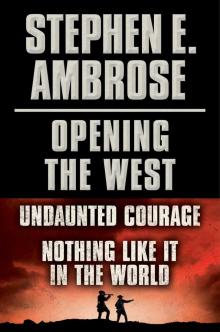 Undaunted Courage
Undaunted Courage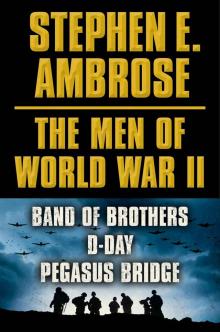 The Victors: Eisenhower and His Boys
The Victors: Eisenhower and His Boys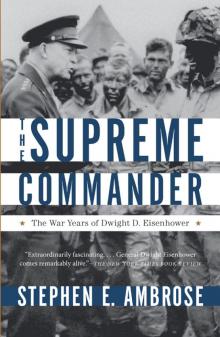 The Supreme Commander
The Supreme Commander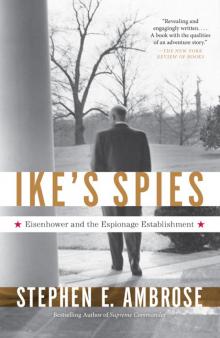 Ike's Spies: Eisenhower and the Espionage Establishment
Ike's Spies: Eisenhower and the Espionage Establishment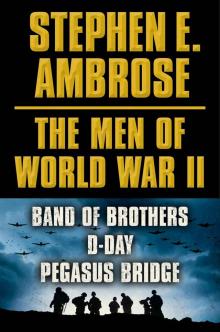 The Men of World War II
The Men of World War II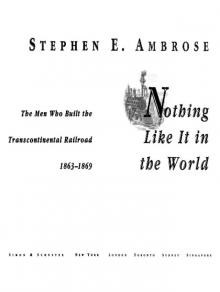 Nothing Like It in the World The Men Who Built the Transcontinental Railroad 1863-1869
Nothing Like It in the World The Men Who Built the Transcontinental Railroad 1863-1869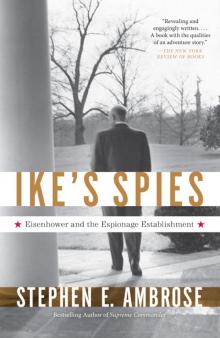 Ike's Spies
Ike's Spies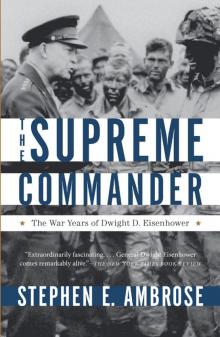 Supreme Commander
Supreme Commander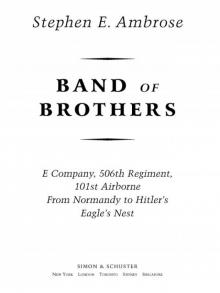 Band of Brothers
Band of Brothers